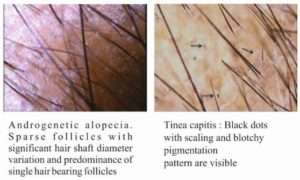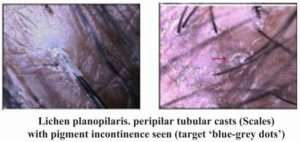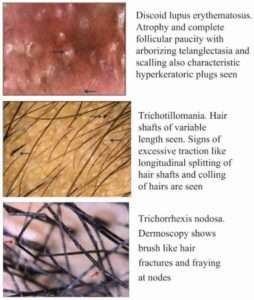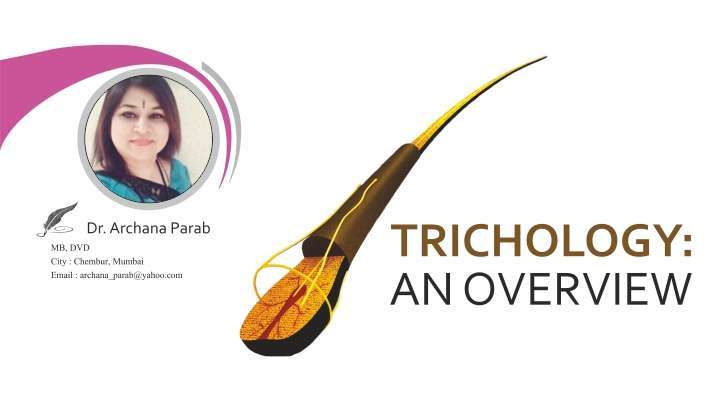Today’s world is inching towards more of a cosmetic era. Hair is considered a major aesthetic display feature of human appearance. Today hair loss or thinning is a common complaint in clinical practice.
The impact of hair loss on a patient confidence varies and they seek medical advice most frequently nowadays as there are profound psychological effects, poor self image and loss of self confidence. In trichology practice, androgenic alopecia, telogen effluvium, female pattern baldness, seborrhoeic dermatitis and Alopecia areata are most common problems presented to a dermatologist.
Here, in this article, I have tried to give an overview, a systematic approach to history taking, rough diagnostic test and few salient treatment approach points.
History Taking:
A detailed history includes the chief complaints, past medical/surgical history, addictions, allergies, medications, diet, assessment of stress and family history. Menstrual history, pregnancy and menopause should be assessed in all female patients.
Proper history taking leads to diagnosis of cause. Most common causes are as follows:
- Family history – male or female pattern baldness
- Stress including emotional distress, anxiety, physical stress from surgery, illness, high fever, postpartum
- Chemotherapy
- Seborrheic dermatitis of scalp
- Poor diet esp. iron and proteins deficiency
- Thyroid diseases such as hypothyroidism and hyperthyroidism, LE
- Tinea capitis/Psoriatic scalp/Alopecia Areata
- Hair care practices, use of hair cosmetics, bleaching or other cosmetic procedures) hair styling, frizzy hair, few causatives of hair
- Damage by traction due to fight braiding and clips or using curling irons, dyes
Approximate number of hair lost per day more than 100 (50-100 strand loss/day is normal) or visible scarcity or decrease in hair density need to treated.
Clinical Examination:
For global appearance, texture, color, length, it’s performed in 3 stages.
Stage I: examination of scalp for inflammation, scaling, erythema and follicular opening scarring Alopecia are devoid for follicular units.
Stage II: Distribution pattern and density of hair, focal hair loss in Alopecia Areata. Diffuse hair loss, with scalp hair distribution by scoring system like Hamilton Norwood and Ludwig classification.
Stage III: study the quality of hair shaft (caliber, fragility, length and shape). Tapered hair indicates new growth. Miniaturized hair is also tapered at end but much finer in caliber.
Hair assessment is understood by:
- Hair growth assessment
- Structural and functional assessment
- Scalp biopsy
- LAB test
A. Hair growth assessment done by:
- Pull Test: Bundle of 50-60 strands grasped between thumb, index & middle fingers from near the base pulled non forcibly, if 10% are pulled away it suggests positive pull test and implies active hair shedding, if less then normal physiological shedding.
- Modified Wash test: After 5 days’ abstention from shampooing, the patient washes and lost hair is collected and analyzed. I) Long Hair (> 5cm) 2) intermediate (> 3 to 5 Cm) 3) Short vellus hair (<3 cm). Hair shorter than 3 cm is telogen vellus hair. Suggestive of four possible diagnosis AGA, TE, AGA + TE and remittent TE.
- Global Photography
- Unit area trichogram
- Trichoscopy



B. Structural and Functional:
Assessment is done by optical light and polarized microscopy and electron microscopy. For hair shaft defects like tapered end, broken hair, pili torti.
C. Scalp Biopsy:
It is an important tool in hair analysis in non-scarring alopecia a punch in the center of the lesion suitable whereas in scarring alopecia sample from the active peripheral margin taken.
D. Laboratory Tests:
It is carried out to support diagnosis or to plan treatment. Basic evolution for
- Thyroid dysfunction – Thyroid profile
- Iron deficiency anaemia – Serum iron and ferritin
- In women with andnogenetic alopeina and virilising signs such as acne, hirsutism and / or irregular menses. Endocrine panel – free testosterone, prolactin, 17 hydroxy progesterone, cortisol to R/o hyper androgenic states.
- For scarring alopecia secondary to DLE and LE – antinuclear antibody analysis done
- For syphilitic alopecia – a rapid reagin test done
Therapeutic Armamentanium in Androgenic Alopecia
- Topical – Minoxidil
- Peptides
- Retinoids
- Systemic – Finasteride / Dutastende
- Cyclical Nutrient Therapy
- Stimulants – Laser helmet
- PRP mesotherapy
- Procedural – Hair Transplantation (FUE/FUT/FUSS)
(Patient should have sufficient donor area in the occipital area}
- Scalp Reduction / resection
- Scalp Hygiene – Anti dandruff shampoo and daily use of shampoo
A few salient points helpful in treatment are that minoxidil is still the gold standard in treatment of AGA by causing vasodilation starting with higher concentration 10% / 12.5 %, following therapeutic results slowly tapering the concentration to 7.5 and the 5% in male and 2 % in females preferably using high concentration for once at bed time eg 10% in males and 5% in females.
If patient is allergic to alcohol based minoxidil lotion, you may use gel based product.
Minoxidil with tretinoin also found quite superior in practical therapeutic effect.
Topical finasteride has no added advantage but in fact may increase the side effects if given along with oral finasteride.
- Saw Palmetto, biotin, tripeptides, tetrapeplides, caffeine, cococin and herbs may be improving hair anchoring, stimulating fibroblast, inhibiting 5αreductase, and improving absorption of minoxidil.
- Cyclical therapy of micro nutrients is used to deal with hidden hunger. On a daily basis, medication with B Complex, biotin, amino acids and antioxidants, while calcium, and iron on alternate day will achieve their maximum absorption and folic acid – twice a week. This helps in conversion of telogen phase to anagen phase by rapid cell division and prolonging Anagen phase. Biotin and B complex help catalyse the metabolic process.
Laser Helmet:
Hair growth with special low light laser therapy (LLLT) is US FDA approved for treatment for hair loss.
- Acts by improving the blood flow and oxygenation to hair roots.
- Controls over activity of sebum glands, reduces irritation, inflammation and reduces dandruff.
- More than 30% of hair which are dormant or in catagen phase are stimulated and saved from becoming dead.
Mesotherapy by PRP:
Platelet concentration is 10 lacs / cubic mm in 5 ml PRP. There is a minimum 4 fold increase in baseline platelet concentration. It helps in stimulation by growth factors.
It is done by point by point injection technique or using dermoroller before or after application of PRP on the scalp. It requires a monthly sitting for first 3 months and later after 45 days to 2 months. Total 6 to 8 sittings recommended depending on grade of Androgenic alopecia, female pattern alopecia and telogen effluvium. Last 2 indications require a few sittings. It can be tried in severe alopecia areata – totalis and universalis.
IM triamcinolone acetonide is a very good option in refractory Alopecia Areata. Intralesional steroids wih oral and tropical medication for Alopecia areata gives therapeutic effect. Good response also seen to 1 % anthralin in children.
Alopecia due to systemic diseases like thyroid dysfunction DLE, LE, Tinea capitis also require system therapeutic treatment of the causative disease.
Thus, a dermatologist can scientifically treat all alopecia patients with excellent therapeutic results. The innocent public gets attracted by unscrupulous advertisements of quacks or so called trichologists by false propaganda, unscientific and unethical practice in the name of trichology. Thus, public awareness that dermatologists are the true trichologists is the need of the hour. It’s all about how dermatologists win in this trichology race!!
*-*-*






